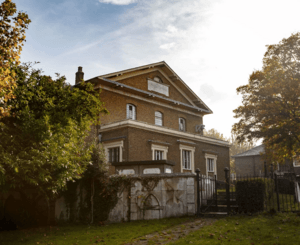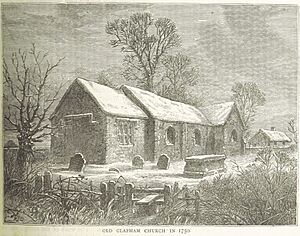St Paul's Church, Clapham facts for kids
Quick facts for kids St Paul's Church, Clapham |
|
|---|---|

Three bay West End under pediment with plaque "1815 ST PAULS CHURCH" with lunette over
|
|
| 51°28′08″N 0°08′25″W / 51.4689°N 0.1403°W | |
| OS grid reference | TQ 29267 76074 |
| Location | Rectory Grove, Clapham, Greater London, SW4 0DX |
| Country | England |
| Denomination | Church of England |
| Churchmanship | Inclusive Central |
| History | |
| Status | Active |
| Architecture | |
| Functional status | Parish church |
| Heritage designation | Grade II* listed |
| Designated | 14 July 1955 |
| Architect(s) | Christopher Edmonds |
| Completed | 1815 |
| Construction cost | £5000 |
| Specifications | |
| Materials | London stock brick, Slate roof |
| Bells | 1 |
| Administration | |
| Parish | Clapham St Paul |
| Benefice | Clapham St Paul |
| Deanery | Lambeth North |
| Archdeaconry | Lambeth |
| Episcopal area | Kingston episcopal area |
| Diocese | Diocese of Southwark |
| Province | Province of Canterbury |
St Paul's Church is a Church of England parish church located in Clapham, London. There has been a church on this spot since the 1100s. The building you see today was finished in 1815. It is a special building, listed as Grade II* listed, which means it's very important historically.
The church grounds are also special. They have won a Green Flag Award, which means they are a well-managed and beautiful green space. You can find old tombs there, including many stone coffins from the early 1800s. There's also a community garden called Eden. The current leader of the church is Revd Canon Jonathan Boardman.
Contents
A Look Back: The History of St Paul's Church
The first church in Clapham was called St Mary's Church. It was built way back in the 12th century. After a big change in religion called the Reformation, St Mary's was renamed Trinity Church.
In 1774, this old church was taken down. A new church, Holy Trinity Church, Clapham, was built nearby on Clapham Common in 1775. However, part of the old church, the north aisle, was kept. It was used for burials.
St Paul's Church was built in the early 1800s. It stands on the same spot where the old St Mary's/Trinity Church used to be. The building was completed in 1815. It was first used as a smaller church, or "chapel of ease," for Holy Trinity. In 1861, it became its own separate church district.
How the Church Was Built: Architecture and Design
The architect who designed St Paul's Church was Christopher Edmonds. He was from Newington, Surrey. The church was built using stock brick, a common type of brick in London. It has a gently sloped slate roof. The building is designed in the classical style, which means it uses ideas from ancient Greek and Roman buildings.
When it was first built, St Paul's was a simple rectangular building. It had balconies, called galleries, inside at the back and along the sides. In 1875, the church was made bigger by Sir Arthur Blomfield. He added a transept (the arms of the cross shape), a chancel (the area around the altar), and a lower, half-round apse at the east end.
St Paul's is now a cruciform church, meaning it's shaped like a cross. It has an entrance porch at the west end and a wide main area (nave) with side aisles. The Victorian parts added by Blomfield have round-arched windows. The side galleries inside the church were removed in 1928.
During World War II, on May 10, 1941, the church was badly damaged by bombs. Fire bombs landed on the roof and burned through. This damaged the chancel and the area around the altar. After the war, the church was fully repaired and redecorated. On July 14, 1955, it was officially recognized as a grade II* listed building. This means it's a very important historic building. In 1970, the church was reorganized inside. The south transept became a Lady chapel, a special area for prayer.
St Paul's Church Today
St Paul's is part of the Church of England. It follows a "central" tradition, which means it blends different styles of worship. The church is part of the Archdeaconry of Lambeth and the Diocese of Southwark.
The Church Organ
The large pipe organ at St Paul's was built in 1886 by a company called Forster and Andrews. The organ used to be in the south transept, which is now the Lady Chapel. This changed after the church was reorganized in 1970. In 2019, the organ was completely rebuilt by Andrew Cooper & Co. Ltd., making sure it sounded just like it did originally.
A Hub for the Community: The Community Centre
In 1970, the East End part of the church, which was designed by Blomfield, was turned into a community centre. This made the church itself smaller, returning it closer to its original size. The centre is a busy place! It hosts a Montessori nursery school for young children. Many different groups also use the centre, including a community choir. The church building is also used for performances. An opera company, a chamber music group, and a theatre group called Paul's Players all put on shows there.
The Churchyard: A Green Space with History
The churchyard, the land around the church, was closed for burials in 1854. Some of the people buried here were soldiers from the English Civil War. Most of the old gravestones have been removed over time. However, in the 1920s, a person named Revd TC Dale wrote down records of all the gravestones and messages on them that were still there.
Today, the churchyard is home to "Eden at St. Paul's." This is a popular community garden. It's one of the longest-running sites in Lambeth to have won the Green Flag Award. This award celebrates well-managed green spaces.
Important Tombs in the Churchyard
- The Hibbert family: This includes George (1792–1795), the first child of George Hibbert and Elizabeth Margaret Hibbert.
- The Atkins family: This includes Sir Richard Atkins, the first Baronet of Clapham.
Notable People Who Served the Church
- Helen Cunliffe: She later became the Archdeacon of St Albans. She was the church's first female vicar from 1994 to 1995. Before that, she was the deacon-in-charge starting in 1989.
- Justine Allain Chapman: She later became the Archdeacon of Boston. She served as vicar from 1997 to 2004.
- Deborah Matthews: She is now the vicar of the Parish of Verwood. She was the parish's third female vicar in a row, serving from 2004 to 2017. She was also the Area Dean from 2013 to 2017.
Memorials Inside the Church
Inside St Paul's Church, you can find memorials to many important people:
- Atkins baronets: A memorial thought to be made by William Stanton.
- Bartholomew Clerke: He was the Lord of Clapham Manor.
- John Hatchard: A famous publisher and bookseller.
- William Hewer: A large, impressive memorial from the Baroque period. It is believed to be by Francis Bird and was inspired by a memorial in Rome.
- Martin Lister: A doctor who worked for Queen Anne.
- Henry Thornton: A key member of the Clapham Sect, a group of social reformers.
- Henry Venn (Clapham Sect): Another important member of the Clapham Sect.
- John Broadley Wilson (1764–1835): He was the Treasurer of the Baptist Missionary Society. His memorial was made by Francis Leggatt Chantrey.
Looking at History: Contested Heritage
In 2020, after the Black Lives Matter protests, the Lambeth Council asked for a review. This review looked for places in Lambeth that had links to the historic trans-Atlantic slave trade and colonialism. Both the memorial plaque for William Hewer and the Hibbert family tomb at St Paul's were found to have connections to this history.
The current vicar of St Paul's is also a trustee of the Hibbert Almshouse Charity. This charity manages the Hibbert Almshouses, which are located within the church's parish area.





